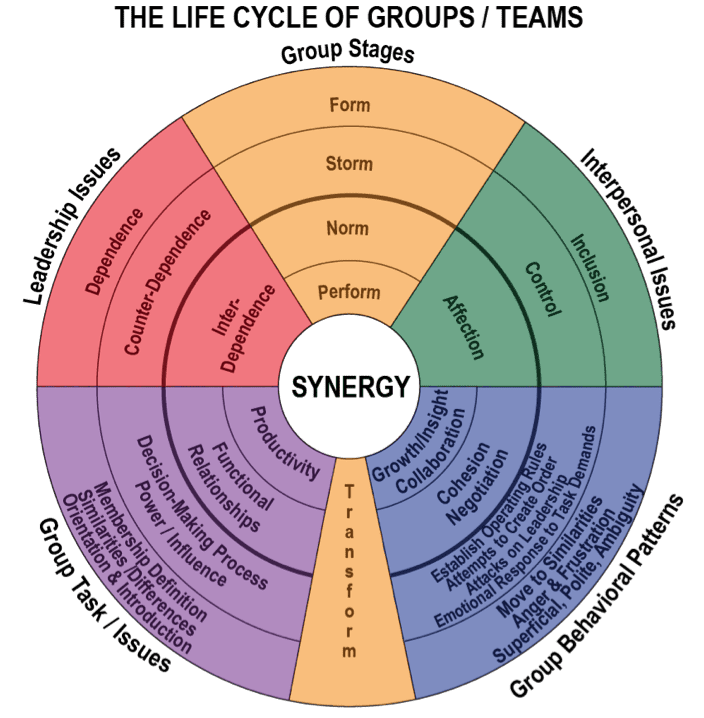What do you see as the allure of working or playing on a team? Learning a new skill? Making new friends? Increasing your happiness quotient, i.e., your positive emotions? Martin Seligman discovered the difference between extremely happy and extremely miserable people is that happy people are very social. Thus alongside what Seligman claims are drivers of happiness — engagement and meaningfulness — we know relationships are also a key indicator. A simple proof of this exists in its opposite. For anyone who has experienced extreme unhappiness, that is, mental illness — depression, anxiety, addiction, psychosis, etc. — you also know withdrawal from others is its universal symptom.
For all the conflict in our relationships with people, we are still happier, more engaged and live more meaningful lives with than without them. Much has been said about our preference to work alone versus on a team, but even the most introverted of us needs to satisfy our sense of belonging within family, workplace and community.
So, how can your group or organization increase its level of happiness and its overall wellbeing — harmony, productivity and innovation? Seligman provides us some hints when we consider his PERMA model and its five pillars of wellbeing:
Positive emotions — joy, gratitude, serenity, interest, hope, pride, amusement, inspiration, awe and love
Engagement — full absorption in challenges that use one’s strengths
Relationships — positive, deep connections with others
Meaning — belonging to and serving something greater than oneself
Accomplishment — contributing and mastering one’s potential
Many organizations I work with value these wellbeing pillars but are uncertain how to create this experience in their workplace. When I ask what culture currently exists rarely do I hear that collaboration or working together is valued. In other words, teamwork may be desired by everyone, but it is not supported by the corporate systems, processes and structures.
A simple example of how organizations contradict their desire for a team culture is when it comes to bonus time. Paying bonuses based on individual performance promotes competition rather than collaboration among organizational members. It is wise to remember that willingness precedes skill when it comes to team collaboration.
Given that our learned conflict resolution strategy around the globe is war and competition, it would be naïve to think that just because we put a group of people together they know how to operate effectively as a team. Teamwork requires personal and organizational development as well as system and structure redesign to transform a command and control hierarchy into a team-based culture and structure.
Here are some beginning steps any organization can take to create a teamwork culture.
1. Agree on a set of teamwork principles.
How will all of you relate and work together?
2. Assess where you are today.
What does everyone view as the current culture?
3. Identify where you would like to be.
What does everyone view as the desired culture?
4. Create an action plan to bridge the gap between your actual and desired states.
What design and development are needed to achieve the desired culture and its supportive structures?
Below is a simple checklist for helping your team or organization assess where you are today. Have each person review the five stages of group development. Based on their defining statements, have everyone identify in what stage they feel you are currently operating.
Forming – stage 1
- high dependence on the leader for guidance and direction
- little agreement on team aims other than those received from the leader
- individual roles and responsibilities are unclear
- leader answers lots of questions about the team’s purpose, objectives and external relationships
- processes are often ignored
- members test the tolerance of the system and leader
- leader directs (“you go there”; “you do this”)
Storming – stage 2
- decisions don’t come easily within the group
- team members vie for position as they attempt to establish themselves with the leader, who might also receive challenges from team members
- clarity of purpose increases but plenty of uncertainty persist
- cliques and factions form and there may be power struggles
- team needs to be focused on its goals to avoid becoming distracted by relationships and emotional issues
- compromises may be required to enable progress
- leader coaches (“what seems to be getting in the way of changing this?”)
Norming – stage 3
- agreement and consensus has formed within the team, who respond well to the leader
- roles and responsibilities are clear and accepted
- big decisions are made by group agreement
- smaller decisions may be delegated to individuals or small work teams within the overall group
- commitment and unity is strong
- team may engage in fun and social activities
- team discusses and develops its processes and working style
- general respect for the leader with some leadership shared by the team
- leader facilitates and enables (“how can you change this?”)
Performing – stage 4
- team is more strategically aware — knows clearly why it is doing what it is doing
- team has a shared vision and stands on its own feet with no interference or participation from the leader (self-managing)
- team is focused on over-achieving goals, and makes most decisions against criteria agreed upon with the leader
- team has a high degree of autonomy — disagreements occur but are resolved positively with any necessary changes to processes and structure made
- team is able to work towards achieving its goal and attending to relationship and process issues along the way
- team members look after each other
- team is delegated tasks and projects from the leader but does not need to be instructed or assisted
- team members might ask for assistance from the leader with personal and interpersonal development
- leader delegates and oversees (“who will take responsibility to see this is done?”)
Transforming – stage 5
- occurs when the team’s purpose changes or ends (is fulfilled) resulting in its break-up or reformation
Source: adapted from Bruce Tuckman 1965, Alan Chapman 1995-2005, www.businessballs.com
In a teamwork culture, the primary aim of the leader or manager is to develop the team through the first four stages and then to move on to another role. S/he essentially works herself out of a job. Effective organizations place an extremely high value on leaders and managers who can achieve this development goal. Would you say your leaders are developing their people to self-manage?
Click here, for other free Joy Tools.





